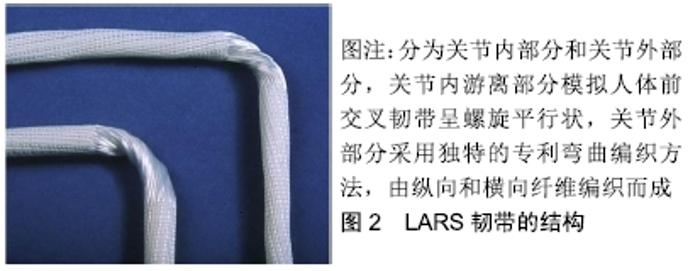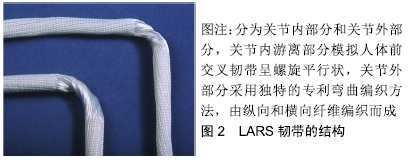Chinese Journal of Tissue Engineering Research ›› 2020, Vol. 24 ›› Issue (8): 1287-1292.doi: 10.3969/j.issn.2095-4344.2204
Previous Articles Next Articles
Clinical application and focus of LARS ligament in anterior cruciate
ligament reconstruction
Chen Wei, Zou Gang, Liu Yi
- Department of Orthopedics, First Affiliated Hospital of Zunyi Medical University, Zunyi 563000, Guizhou Province, China
-
Received:2019-05-06Revised:2019-05-21Accepted:2019-06-22Online:2020-03-18Published:2020-01-23 -
Contact:Liu Yi, Master’s supervisor, Chief physician, Department of Orthopedics, First Affiliated Hospital of Zunyi Medical University, Zunyi 563000, Guizhou Province, China -
About author:Chen wei, Master candidate, Department of Orthopedics, First Affiliated Hospital of Zunyi Medical University, Zunyi 563000, Guizhou Province, China -
Supported by:Project supported by Guizhou Science and Technology Foundation, No. Qiankehe LH [2016] 7477
CLC Number:
Cite this article
Chen Wei, Zou Gang, Liu Yi.
Clinical application and focus of LARS ligament in anterior cruciate
ligament reconstruction
share this article
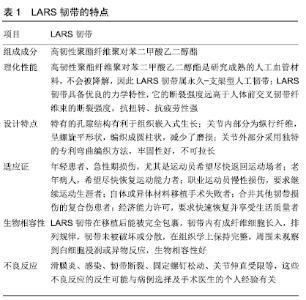
LARS韧带于1985年由法国的Dr. Laboureau应用高韧性聚酯材料聚对苯二甲酸乙二醇酯模仿人体韧带的解剖结构和生物力学原理设计而成(表1)。这是一种类似于“脚手架”的移植物,在大多数欧洲国家已被广泛应用。LARS韧带可分为关节内部分和关节外部分,关节内部分模仿前交叉韧带的两束结构(分别为左右独立设计),由无横向纤维的纵向外旋纤维组成,这种聚对苯二甲酸乙二醇酯纤维特有的孔隙结构,纤维小孔大小为30-50 μm,适合组织长入、包裹,增加了韧带的黏弹性,减少了纤维间的磨损,可防止脱屑且不被降解,组织相容性好;关节外部分由纵向和横向纤维编织而成,有满意的抗疲劳强度,以避免韧带变形(图2)。60根纤维编织的LARS韧带断裂强度为2 500 N,80根则为3 600 N,均高于人体前交叉韧带纤维束断裂强度。LARS韧带良好的生物力学性能可抗重复的扭转、弯曲及因牵引过度而造成的损害[12-14]。在后来的体内和体外实验中都证明了这些观点。 "
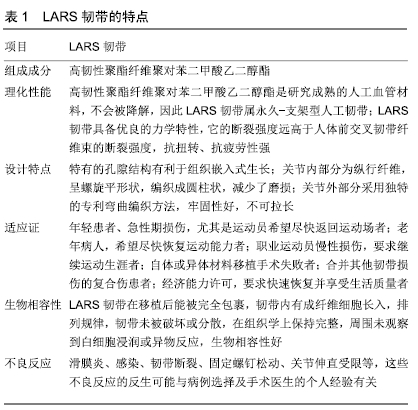

2.1 LARS韧带的生物相容性和生物力学研究 TRIEB 等[15]将重建前交叉韧带术后6个月失败的LARS韧带取活检,再将人成纤维细胞或成骨样细胞(106个细胞,共21 d)接种于韧带片(5.5 mm)上进行体外实验研究。活检显示LARS韧带内有完整的细胞和结缔组织,组织学细胞类型无差异,韧带未被破坏或分散,在组织学上保持完整,未观察到白细胞浸润或异物反应。在体外研究中,成纤维细胞和成骨细胞通过在LARS韧带周围建立一个细胞网状结构来包覆纤维。体内和体外实验结果表明,LARS韧带拥有良好的生物相容性,这些发现首次证明细胞进入LARS韧带,这一机制可能解释了LARS韧带的强度和惰性行为,而没有临床研究显示的滑膜炎。 翟昕元等[16]将20只山羊随机分为保留前交叉韧带残端组(n=10)和不保留前交叉韧带残端组(n=10)进行前交叉韧带重建。研究中两组LARS人工韧带在关节腔内游离部分和骨隧道内被大量自体组织包绕,呈长梭形排列。扫描电镜下两组均在LARS人工韧带之间存在明显的致密纤维组织,LARS人工韧带表面覆盖较多自体组织,高放大倍率下可见LARS人工韧带的自体纤维组织排列紧密、均匀;剖面下LARS人工韧带光洁、边缘整齐,韧性、刚度良好,见图3。 "
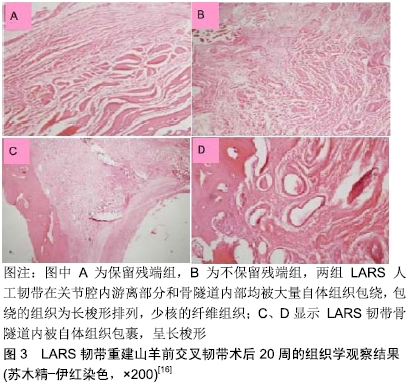

2.2 LARS韧带重建前交叉韧带的临床疗效研究 2.2.1 短期疗效 国外最早出现LARS韧带并应用于临床是在1985年的法国,随后从DERICKS等[17]在1995年首次报道LARS韧带在前交叉韧带重建中的临床疗效开始,它的短期疗效就取得了令人满意的效果。随着LARS韧带在欧美的广泛应用,LAVOIE等[18]也报道了LARS韧带重建前交叉韧带后的短期疗效优良,其将患者满意度与膝关节稳定性的客观测量值相比较,认为临床检查膝关节稳定性的客观结果与患者主观满意度之间的相关性不大,特别是在日常生活能力方面,患者对前交叉韧带重建术后疗效的主观满意度甚至超出了临床检查的客观结果;从而LAVOIE等[18]得出LARS韧带可能是重建前交叉韧带安全选择的结论。最初普遍认为骨-髌腱-骨是重建前交叉韧带的金标准,随后NAU等[19]更是比较了采用骨-髌腱-骨重建前交叉韧带和LARS韧带重建前交叉韧带的效果,发现术后1年时LARS组膝关节功能评分更高、松弛度低,LARS组在术后4个月时就恢复了运动活动,他们认为LARS韧带在重建前交叉韧带的早期疗效值得肯定。 为了佐证这一结果,中国从2004年引进LARS韧带后,国内众多运动医学研究中心开始报道LARS韧带重建前交叉韧带的早期疗效。郭林等[20]回顾性分析了80例应用LARS韧带重建前交叉韧带损伤患者的临床资料,随访时间7-24个月,术后发生3例股骨侧螺钉外露、2例胫骨侧螺钉松动、1例伸膝受限,均对症处理,随访期间均无LARS韧带断裂、关节僵硬等并发症发生,所以他们认为LARS韧带重建术中需要在偏伸直位固定,避免屈曲受限,屈曲位允许移植物有轻微松弛,对手术医生的要求较高,只要掌握其特殊手术技巧后,以LARS韧带作为移植物重建前交叉韧带便能获得较好的近期疗效。王海明等[21]认为LARS韧带可成功用于前交叉韧带重建,重建效果确切,术后短期随访中无不良反应,特别适用于有尽早恢复运动水平要求的患者。陈世益 等[22]报道了LARS韧带重建前交叉韧带后50个月的疗效优良,其中1例发生了严重的滑膜炎。 LARS韧带重建前交叉韧带术后出现的膝关节滑膜炎,是其重建前交叉韧带的严重并发症之一,引起了国内外专家学者的广泛关注。LARS韧带作为人工合成韧带似乎避免不了异物反应引起的膝关节滑膜炎。虽然从一个案例中得出过于坚定的结论是不明智的,但GLEZOS等[23]坚持认为使用LARS韧带应该非常谨慎,其报道了1例LARS韧带植入后6个月出现严重滑膜炎而导致重建失效并需要在1年内翻修的病例。通过这次案例报道,他们建议外科医生对这些应用LARS韧带重建前交叉韧带的潜在问题保持警惕,如果出现这种情况应进一步调查和报告。与此同时SINAGRA等[24]认为,尽管LARS公司致力于通过改进设计及生物材料的研发来减少并发症,但LARS韧带仍可能与临床上显著的异物反应有关。所以LARS韧带的使用应该谨慎,所有患者都应密切跟踪、监测和调查潜在的不良影响,特别是与异物反应发展有关的不良反应。 迄今为止,大量研究提供了使用LARS重建前交叉韧带术后短期疗效的观测数据,表明LARS的术后疗效与自体移植物重建疗效相当;但是需要辨证地看待此结果。在2013年的一篇系统性回顾发现,LARS韧带重建前交叉韧带的短期并发症发生率(包括移植失败和滑膜炎等)与自体移植物一样低,但是为了确定LARS韧带的长期安全性和有效性,需要进一步高质量、理想控制的中长期随访研究,并且在研究中加入一些潜在的问题研究,这些问题应包括评估LARS韧带相对于自体移植技术的潜在成本或者效益,例如降低供体部位的发病率、加快康复、减少手术时间和费用等。现有的证据均有效支持短期内继续使用LARS韧带作为一种安全的移植物这一观点,但需要更多的中期和长期研究确定其是否真正优于自体移植物,以便为其使用建立安全的临床指南[25]。 2.2.2 中期疗效 美国的骨科医生对20世纪前交叉韧带重建中滥用人工韧带引起的膝关节严重滑膜炎和植入物断裂等问题仍记忆犹新,因此他们认为自体移植和异体移植是目前前交叉韧带重建的主要材料[26-28]。但在人口众多的中国,人工韧带目前再次被用于前交叉韧带重建。因此应用人工韧带重建前交叉韧带的有效性和安全性已成为中国骨科医生关注的焦点。LARS韧带的短期疗效已得到了国内外医生的广泛认可,随着2004年国内各家研究中心使用LARS韧带重建前交叉韧带至今,中国的骨科医生开始中期随访LRAS重建前交叉韧带的患者。GAO等[29]回顾了159例在中国4所大学附属大型骨科运动医学中心应用LARS韧带进行前交叉韧带重建患者的资料,术后随访3-5年,其中3例因意外导致LARS人工韧带断裂,1例出现膝关节滑膜炎,3例出现骨隧道的空洞,最后随访时LARS人工韧带的失败率为4.4%(7/159),这项研究表明LARS人工韧带前交叉韧带重建的结果与以前报道的结果相似[16,18]。LARS人工韧带适用于保留前交叉韧带残端患者的前交叉韧带重建,无论是急性还是慢性损伤。 曾经的自体骨-髌腱-骨移植,因其长期较好的疗效并具有骨与骨的愈合而曾被作为前交叉韧带重建的金标准[3-4]。PAN等[30]将LARS韧带与骨-髌骨肌腱-骨重建前交叉韧带的病例进行中期随访(至少4年),其中复发不稳定发生率LARS韧带组为9.38%(3/32)、骨-髌骨肌腱-骨自体移植物组为6.67%(2/30),他们认为在中期随访中使用骨-髌骨肌腱-骨自体移植和LARS人工移植重建前交叉韧带同样有良好的临床效果。这也与NAU等[19]的研究结果一致。 随着越来越多临床医生认可自体腘绳肌腱应作为前交叉韧带重建的首要选择。施犇等[31]回顾性比较前交叉韧带重建术中使用自体腘绳肌腱与LARS韧带作为移植物的中期临床疗效,采用自体腘绳肌腱重建前交叉韧带33例,采用LARS韧带重建前交叉韧带29例,两组都有个别失败病例,但是该患者都有明确的二次受伤史,所有随访患者手术失败率和并发症发生率都较低。Lysholm评分、目测类比评分和Tegner运动评分主要是从患者的主观角度对疼痛感受、日常活动、膝关节稳定度及运动功能方面进行评价。运用这些评分评估后,结果表明两组患者术后中期主观感觉疗效都较好,且两组间无明显差异。IKDC评分和KT-2000检查结果则从客观角度对患者进行影像学检查、体格检查等评价,在客观评估中两组的中期疗效依旧良好,且两组之间评分亦无明显差异。值得注意的是,在统计患者术后重回娱乐性运动时间时两组患者有明显差异,自体腘绳肌腱组重返运动的时间为(20.21±5.40)周,而LARS组为(13.13± 4.29)周,LARS人工韧带组较自体腘绳肌腱组能够早期回归运动,缩短康复时间,这与国内关于关节镜下LARS韧带重建前交叉韧带的中期随访研究结果相符合[32-33]。LARS韧带重建前交叉韧带能取得较好的中期临床效果,与自体移植物相当,是较好的移植材料。未来研究中可能需要多中心合作,纳入更多样本量,以及收集更多失败病例进行讨论。当LARS韧带重建前交叉韧带的远期疗效得到认可,人工韧带将会展现良好的前景[34]。 2.2.3 远期疗效 2013年PARCHI等[35]对LARS韧带重建膝关节韧带的临床结果进行了文献回顾,并在4个不同的数据库(PubMed、Scopus、Embase和Google Scholar)中搜索,发现了35篇论文,共计1 245例患者,随访时间从3个月到9年不等。他们将注意力集中在移植破裂的数量和膝关节滑膜炎的数量,认为这些并发症都与人工韧带的使用有关,其中移植物破裂12例(0.96%),膝关节滑膜炎3例(0.24%)。这些数据结果被最近的两次系统评论所证 实[36-37]。ANDERSON等[36]报告了使用LARS韧带和自体移植物在中远期随访后有类似的结果。BATTY等[37]对LARS韧带和其他人工韧带(Leeds-Keio、Kennedy-LAD、Dacron、Gore-Tex和Trevira)的并发症和临床结果进行了比较,报告了LARS韧带的累积失败率最低(前交叉韧带为2.6%,后交叉韧带手术为1%),非感染性滑膜炎和积液的发生率LARS为0.2%、Gore-Tex为27.6%,翻修率LARS韧带最低,他们认为LARS韧带的临床疗效显著高于其他人工韧带,更加适用于前交叉韧带重建。 虽然LARS韧带自20世纪90年代末开始用于前交叉韧带重建,但鲜有研究分析长期结果,有时报道的数据不一致。在一份对26例患者平均随访8年的临床疗效研究中,将评价方案分为3个部分:①主观评价采用VAS、KOOS和Cincinnati膝关节评分量表;②临床和客观评价;③膝关节稳定性生物力学评价。结果总阳性率为92.3%(16例最优,8例良好),功能恢复快,膝关节稳定性高,没有记录感染或膝关节滑膜炎的病例,只记录了1例手术58个月后因移植物断裂失败的病例,该病例在第一次使用LARS韧带后因再次高强度运动活动受 伤[35]。CERULLI等[38]报告了25例使用LARS韧带重建前交叉韧带术后随访9年的结果,95%以上无膝关节滑膜炎病例。JIA等[39]报告了91例患者术后随访7年的结果,失败率为4.4%,总并发症发生率为2.2%,86.6%的患者恢复了体育活动。WANG等[40]报告了26例LARS重建前交叉韧带平均随访11.9年的结果,出现膝关节滑膜炎2例,这些病例中失败的突出原因之一是固定系统的松动。TIEFENBOECK等[41]的研究至少随访10年,报道了患者满意度低(55.6%)、并发症发生率高(56%),并发症包括运动中移植物断裂3例、手术部位感染3例、残余膝关节不稳4例,无膝关节反应性滑膜炎病例。VIATEAU等[42]研究报道了LARS韧带在骨隧道中的骨整合能力很差,不能用可吸收装置固定,因此TIEFENBOECK等[41]研究结果的差异可能与移植物固定方法有关,不能用可吸收装置进行固定,这导致了术后高并发症率,出现移植物断裂、膝关节不稳、疼痛等问题。为了克服LARS韧带的骨整合问题,几位作者在过去几年致力于利用纳米技术加强移植物的生物固定[43-45]。而另一种降低因膝关节长期反应性滑膜炎导致失效和碎片形成风险的重要方法是保存前交叉韧带残端,如TRIEB等[15]所建议的,保存撕裂的韧带可减少LARS纤维在骨隧道水平和纤维之间的摩擦应力,促进成纤维细胞的生长。 在2018年一篇证据水平为IV级的回顾性案例分析研究中,PARCHI等[46]回顾性分析26例LARS韧带重建前交叉韧带患者的远期疗效,结果显示22例(84.6%)患者对术后疗效满意,4例(15.4%)因移植物松动而再次手术,未报告滑膜炎和感染病例。凭借着低失败率和低并发症,LARS的长期疗效令人鼓舞,LARS韧带可以被认为是重建前交叉韧带的合适选择,特别是对于需要快速功能恢复的患者。 "

| [1] 陆晴友,王予彬,袁锋,等.三种不同移植物重建前交叉韧带的疗效分析[J].中国骨与关节损伤杂志,2009,24(4):295-297. [2] VAISHYA R, AGARWAL AK, INGOLE S, et al.Current trends in anterior cruciate ligament reconstruction: a review.Cureus.2015;7(11):e378. [3] FU FH, BENNETT CH, LATTERMANN C, et al.Current trends in anterior cruciate ligament reconstruction. Part 1: Biology and biomechanics of reconstruction.Am J Sports Med.1999;27(6):821-830. [4] KIM HS, SEON JK, JO AR.Current trends in anterior cruciate ligament reconstruction.Knee Surg Relat Res.2013;25(4):165-173. [5] MILLER SL, GLADSTONE JN.Graft selection in anterior cruciate ligament reconstruction.Orthop Clin North Am.2002;33(4):675-683. [6] SAMUELSSON K, ANDERSSON D, KARLSSON J.Treatment of anterior cruciate ligament injuries with special reference to graft type and surgical technique: an assessment of randomized controlled trials. Arthroscopy. 2009;25(10):1139-1174. [7] BUDNY J, FOX J, RAUH M, et al.Emerging trends in anterior cruciate ligament reconstruction.J Knee Surg.2017;30(01):63-69. [8] HSU HC, HUANG TL, WU JJ. Primary anterior cruciate ligament reconstruction by Dacron prosthesis augmented with iliotibial band or fascia lata: A 14-year subjective outcome study.Mid Taiwan J Med. 2007; 12(02):191-197. [9] SOMMERLATH K, LYSHOLM J, GILLQUIST J.The long-term course after treatment of acute anterior cruciate ligament ruptures, A9 to 16 year followup.Am J Sports Med.1991;19(2):156-162. [10] SHAERF DA, PASTIDES PS, SARRAF KM, et al.Anterior cruciate ligament reconstruction best practice: a review of graft choice.World J Orthop.2014;5(1):23-29. [11] SAVARESE A, LUNGHI E, BUDASSI P, et al Remarks on the complications following ACL reconstruction using synthetic ligaments. Ital J Orthop Traumatol.1993;19(1):79-86. [12] NEWMAN SD, ATKINSON HD, WILLIS-OWEN CA.Anterior cruciate ligament reconstruction with the ligament augmentation and reconstruction system: a systematic review.Int Orthop. 2013;37(2):321-326. [13] HAGEMEISTER N, DUVAL N, YAHIA L, et al.Comparison of two methods for reconstruction of the posterior cruciate ligament using a computer based method: quantitative evaluation of laxity, three-dimensional kinematics and ligament deformation measurement in cadaver knees.Knee. 2002;9(4):291-299. [14] VIATEAU V, MANASSERO M, ANAGNOSTOU F, et al.Biological and biomechanical evaluation of the ligament advanced reinforcement system (LARS AC) in a sheep model of anterior cruciate ligament replacement: a 3-month and 12-month study. Arthroscopy. 2013;29:1079-1088. [15] TRIEB K, BLAHOVEC H, BRAND G, et al. In vivo and in vitro cellular ingrowth into a new generation of artifificial ligaments.Eur Surg Res. 2004;36(3):148-151. [16] 翟昕元,林小风.LARS 人工韧带重建前交叉韧带:生物相容性及与骨组织的愈合[J].中国组织工程研究,2017,21(16):2565-2569. [17] DERICKS G JR. Ligament advanced reinforcement system anterior cruciate ligament reconstruction. Oper Tech Sports Med.1995;3(2):187-205. [18] LAVOIE P, FLETCHER J, DUVAL N.Patient satisfaction needs as related to knee stability and objective fi ndings after ACL reconstruction using the LARS artifi cial ligament.Knee.2000;7(3):157-163. [19] NAU T, LAVOIE P, DUVAL N.A new generation of artifi cial ligaments in reconstruction of the anterior cruciate ligament. Two-year follow-up of a randomized trial.J Bone Joint Surg (Br).2002;84(3): 356-360. [20] 郭林,陈昊,何锐,等.LARS韧带重建前交叉韧带的近期疗效[J].中国修复重建外科杂志,2011,25(8):921-924. [21] 王海明,周自广.关节镜LARS人工韧带重建前交叉韧带的临床价值分析[J].中国综合临床,2018,34(5):449-451. [22] 陈世益,洪国威,陈疾忤,等.LARS人工韧带与自体腘绳肌腱重建前交叉韧带的早期临床疗效比较[J].中国医学工程,2007,15(12):949-953. [23] GLEZOS CM, WALLER A, BOURKE HE, et al.Disabling synovitis associated with lars artificial ligament use in anterior cruciate ligament reconstruction: A case report(Article).Am J Sports Med 2012;40(5): 1167-1171. [24] SINAGRA ZP, KOP A, PABBRUWE M, et al.Foreign Body Reaction Associated With Artificial LARS Ligaments: A Retrieval Study.Orthop J Sports Med.2018;6(12):2325967118811604. [25] NEWMAN SD, ATKINSON HD, WILLIS-OWEN CA.Anterior cruciate ligament reconstruction with the ligament augmentation and reconstruction system: a systematic review.Int Orthop.2013;37(2):321-326. [26] LEBEL B, HULET C, GALAUD B, et al. Arthroscopic reconstruction of the anterior cruciate ligament using bone-patellar tendon-bone autograft: A minimum 10-year follow-up.Am J Sports Med. 2008;36(7):1275-1282. [27] LIDÉN M, SERNERT N, ROSTGÅRD-CHRISTENSEN L,et al. Osteoarthritic changes after anterior cruciate ligament reconstruction using bone–patellar tendon– bone or hamstring tendon autografts: A retrospective, 7-year radiographic and clinical follow-up study. Arthroscopy. 2008;24(8):899-908. [28] NAKATA K, SHINO K, HORIBE S, et al.Arthroscopic anterior cruciate ligament reconstruction using fresh-frozen bone plug-free allogeneic tendons: 10-year follow-up.Arthroscopy.2008;24(3):285-291. [29] GAO K, CHEN S, WANG L, et al.Anterior Cruciate Ligament Reconstruction With LARS Artifificial Ligament: A Multicenter Study With 3- to 5-Year Follow-up.Arthroscopy.2010;26(4):515-523. [30] PAN X, WEN H, WANG L, et al.Bone-patellar tendon-bone autograft versus LARS artificial ligament for anterior cruciate ligament reconstruction. Eur J Orthop Surg Traumatol.2013;23(7):819-823. [31] 施犇,陈烁,周立武,等.自体腘绳肌腱与LARS韧带重建前交叉韧带中期疗效比较[J].中国矫形外科杂志,2018,26(16):1441-1445 [32] 王韵廷,葛茶娜,黎飞猛,等.自体腘绳肌腱与LARS人工韧带重建前交叉韧带临床疗效的荟萃分析[J].中国矫形外科杂志,2017,25(12):1108-1112 [33] 王庆峰,温鹏.自体四股胭绳肌键与 LARS 人工韧带重建前交叉韧带临床疗效比较[J].中国骨与关节损伤杂志,2011,26(12):1113-1114. [34] 程聪,任士友,陈鹏,等.LARS 韧带与自体肌腱重建前交叉韧带疗效比较的 Meta 分析[J].中国矫形外科杂志,2016,24(20):1868-1875. [35] PARCHI PD, GIANLUCA C, DOLFIFI L, et al.Anterior cruciate ligament reconstruction with LARS™ artifificial ligament results at a mean follow-up of eight years.Int Orthop.2013;37(8):1567-1574. [36] ANDERSON MJ, BROWNING WM III, URBAND CE, et al.A systematic summary of systematic reviews on the topic of the anterior cruciate ligament.Orthop J Sports Med.2016;4(3):2325967116634074. [37] BATTY LM, NORSWORTHY CJ, LASH NJ, et al.Synthetic devices for reconstructive surgery of the cruciate ligaments: a systematic review. Arthroscopy.2015;31(5):957-968. [38] CERULLI G, ANTINOLFIFI P, BRUÈ S, et al.Esperienza clinica nell’uti- lizzo di biomateriali nel ginocchio.GIOT.2011;37(01):159-166. [39] JIA Z, XUE C, WANG W, et al.Clinical outcomes of anterior cruciate ligament reconstruction using LARS artifificial graft with an at least 7-year follow-up.Medicine (Baltimore).2017;96(14):e6568. [40] WANG CL,HSIAO CK,KU MC,et al.Arthroscopic anterior cruciate ligament reconstruction with LARS artifificial ligament: an 8-15-year follow-up.J Mech Med Biol.2013;13(2):11. [41] TIEFENBOECK TM, THURMAIER E, TIEFENBOECK MM, et al.Clinical and functional outcome after anterior cruciate ligament reconstruction using the LARS™ system at a minimum follow-up of 10 years. Knee. 2015;22(06):565-568. [42] VIATEAU V, MANASSERO M, ANAGNOSTOU F, et al.Biological and biomechanical evaluation of the ligament advanced reinforcement system (LARS AC) in a sheep model of anterior cruciate ligament replacement: a 3-month and 12-month study.Arthroscopy. 2013;29(6): 1079-1088. [43] LI H, CHEN S, WU Y, et al.Enhancement of the osseointegration of a polyethylene terephthalate artifificial ligament graft in a bone tunnel using 58S bioglass.Int Orthop.2012;36(1):191-197. [44] LI H, GE Y, WU Y, et al. Hydroxyapatite coating enhances polyethylene terephthalate artifificial ligament graft osseointegration in the bone tunnel. Int Orthop.2011;35(10):1561-1567. [45] CHO S, LI H, CHEN C, et al. Cationised gelatin and hyaluronic acid coating enhances polyethylene terephthalateartifificial ligament graft osseointegration in porcine bone tunnels.Int Orthop. 2013;37(3):507-513. [46] PARCHI PD, GIANLUCA C, PAGLIALUNGA C, et al.Anterior Cruciate Ligament Reconstruction with LARS Artifificial Ligament-Clinical Results after a Long-Term Follow-Up.Joints.2018;6(2):75-79. |
| [1] | Pu Rui, Chen Ziyang, Yuan Lingyan. Characteristics and effects of exosomes from different cell sources in cardioprotection [J]. Chinese Journal of Tissue Engineering Research, 2021, 25(在线): 1-. |
| [2] | Liang Yan, Zhao Yongfei, Xu Shuai, Zhu Zhenqi, Wang Kaifeng, Liu Haiying, Mao Keya. Imaging evaluation of short-segment fixation and fusion for degenerative lumbar scoliosis assisted by highly selective nerve root block [J]. Chinese Journal of Tissue Engineering Research, 2021, 25(9): 1423-1427. |
| [3] | Zhang Chao, Lü Xin. Heterotopic ossification after acetabular fracture fixation: risk factors, prevention and treatment progress [J]. Chinese Journal of Tissue Engineering Research, 2021, 25(9): 1434-1439. |
| [4] | Zhou Jihui, Li Xinzhi, Zhou You, Huang Wei, Chen Wenyao. Multiple problems in the selection of implants for patellar fracture [J]. Chinese Journal of Tissue Engineering Research, 2021, 25(9): 1440-1445. |
| [5] | Wang Debin, Bi Zhenggang. Related problems in anatomy mechanics, injury characteristics, fixed repair and three-dimensional technology application for olecranon fracture-dislocations [J]. Chinese Journal of Tissue Engineering Research, 2021, 25(9): 1446-1451. |
| [6] | Ji Zhixiang, Lan Changgong. Polymorphism of urate transporter in gout and its correlation with gout treatment [J]. Chinese Journal of Tissue Engineering Research, 2021, 25(8): 1290-1298. |
| [7] | Yuan Mei, Zhang Xinxin, Guo Yisha, Bi Xia. Diagnostic potential of circulating microRNA in vascular cognitive impairment [J]. Chinese Journal of Tissue Engineering Research, 2021, 25(8): 1299-1304. |
| [8] | Wang Xianyao, Guan Yalin, Liu Zhongshan. Strategies for improving the therapeutic efficacy of mesenchymal stem cells in the treatment of nonhealing wounds [J]. Chinese Journal of Tissue Engineering Research, 2021, 25(7): 1081-1087. |
| [9] | Wan Ran, Shi Xu, Liu Jingsong, Wang Yansong. Research progress in the treatment of spinal cord injury with mesenchymal stem cell secretome [J]. Chinese Journal of Tissue Engineering Research, 2021, 25(7): 1088-1095. |
| [10] | Liao Chengcheng, An Jiaxing, Tan Zhangxue, Wang Qian, Liu Jianguo. Therapeutic target and application prospects of oral squamous cell carcinoma stem cells [J]. Chinese Journal of Tissue Engineering Research, 2021, 25(7): 1096-1103. |
| [11] | Zhao Min, Feng Liuxiang, Chen Yao, Gu Xia, Wang Pingyi, Li Yimei, Li Wenhua. Exosomes as a disease marker under hypoxic conditions [J]. Chinese Journal of Tissue Engineering Research, 2021, 25(7): 1104-1108. |
| [12] | Xie Wenjia, Xia Tianjiao, Zhou Qingyun, Liu Yujia, Gu Xiaoping. Role of microglia-mediated neuronal injury in neurodegenerative diseases [J]. Chinese Journal of Tissue Engineering Research, 2021, 25(7): 1109-1115. |
| [13] | Li Shanshan, Guo Xiaoxiao, You Ran, Yang Xiufen, Zhao Lu, Chen Xi, Wang Yanling. Photoreceptor cell replacement therapy for retinal degeneration diseases [J]. Chinese Journal of Tissue Engineering Research, 2021, 25(7): 1116-1121. |
| [14] | Jiao Hui, Zhang Yining, Song Yuqing, Lin Yu, Wang Xiuli. Advances in research and application of breast cancer organoids [J]. Chinese Journal of Tissue Engineering Research, 2021, 25(7): 1122-1128. |
| [15] | Wang Shiqi, Zhang Jinsheng. Effects of Chinese medicine on proliferation, differentiation and aging of bone marrow mesenchymal stem cells regulating ischemia-hypoxia microenvironment [J]. Chinese Journal of Tissue Engineering Research, 2021, 25(7): 1129-1134. |
| Viewed | ||||||
|
Full text |
|
|||||
|
Abstract |
|
|||||
